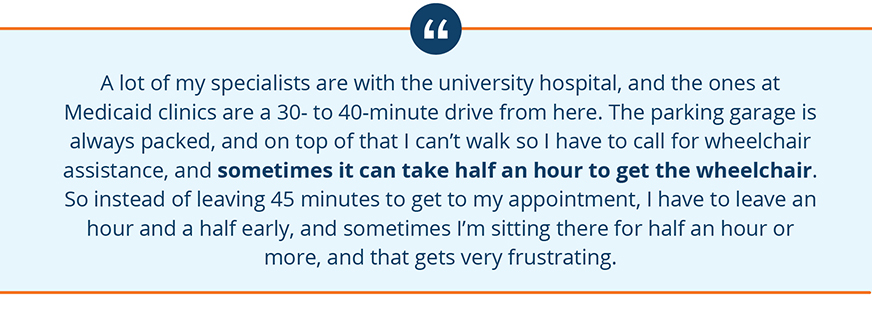What’s it like to live day to day with three or more chronic conditions such as diabetes, heart failure, and dementia? The Commonwealth Fund’s Health Care Delivery System Reform program is focusing on improving care for such high-need patients, who make up the 5 percent of the population that accounts for 50 percent of all health spending. To better understand their experiences, we held video-chat focus groups and phone interviews with adults with three or more health conditions that limit their ability to do things like get out of bed, dress, or bathe themselves. We also conducted a focus group of caregivers. These anecdotal results are based on a small, nonrepresentative sample, but interesting themes emerged that we explore below.
Paying for Care
Affordability was a top concern for these patients. Although most are covered by Medicare,1 many say they struggle to pay bills2 for medications, health insurance premiums, office visit copayments, and home health care. Several noted that they were paying more and more for the same prescriptions.

Accessing Care
Given their many needs and the frequency of their medical visits, these patients are especially interested in having easy access to their doctors and other providers. Common concerns included not being able to get timely appointments, having trouble communicating with their doctors between visits, and waiting a long time to be seen at scheduled appointments. Several reported that during appointments providers seemed rushed and not focused on their complex needs.

Patients also expressed concerns about the logistical difficulties of getting to their appointments. Many reported long journeys to reach specialists in particular. Especially among adults who have difficulty walking or driving, or those who live alone, specialist visits and even routine procedures required an inordinate amount of time and planning.


Insurance Frustrations
Patients expressed an overall lack of trust in insurers, including Medicare, and patients and caregivers were frustrated by limitations and restrictions on treatments.

Technology Can Be Helpful
Most of the patients we spoke to are older adults, but they are also tech-savvy. They use patient web portals for their medical records and provider communication when available. Caregivers and patients alike reported researching their conditions and treatments online using sources such as the Mayo Clinic website, WebMD, and the New England Journal of Medicine.

Getting Help at Home
Some patients and their caregivers were unaware of services to help them with nutrition, transportation, or tasks like laundry or errands. Those who did receive personal care at home generally felt they could use more help, or help for longer periods. Many relied heavily on friends and family to fill those gaps. Those who lived alone largely valued their independence, but most patients and their caregivers did not have a solid long-term plan for home care.


Even with Medicare, many high-need, high-cost adults are frequently underinsured and face high cost burdens, particularly those who are older and disabled.2 Providers and payers could consider services such as telemedicine, visiting nurses, and transportation that can help effectively engage and care for mobility-limited patients in a cost-effective manner. Though the focus-group patients were likely more familiar with technology than the average patient given their willingness to engage in video chats, comfort with technology is a quality, or “resiliency factor,” researchers should consider when developing programs to help these patients manage their health. To review our work on this population so far, visit our High-Need, High-Cost Populations page—and look for more research on defining and designing solutions for these patients.
Research conducted by SSRS and methodology available upon request.
Notes
1 According to the U.S. Department of Health and Human Services, two of three Medicare beneficiaries have multiple chronic conditions. See U.S. DHHS, “About the Multiple Chronic Conditions Initiative.”
2 C. Schoen, C. Solís-Román, N. Huober et al., On Medicare But At Risk: A State-Level Analysis of Beneficiaries Who Are Underinsured or Facing High Total Cost Burdens (The Commonwealth Fund, May 2016).
